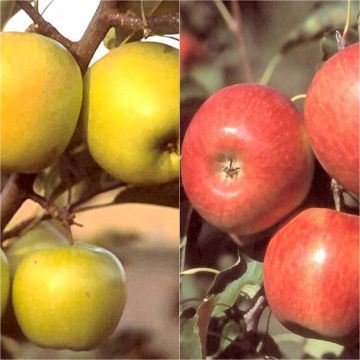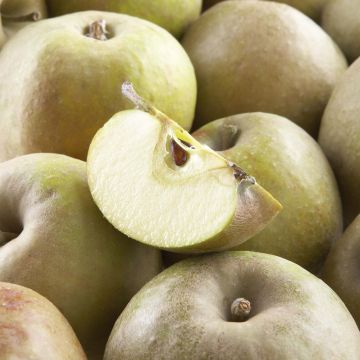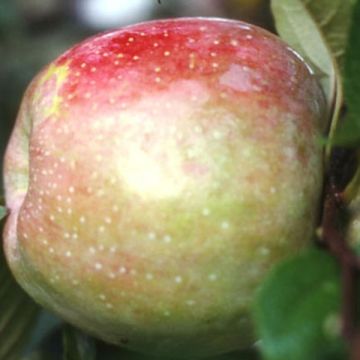

Pommier Blush rosette - pomme sanguine
Red-fleshed Apple Tree Blush Rosette - Malus domestica
Malus domestica Blush rosette
Apple, Orchard apple, Table apple, Cultivated apple
This item cannot be shipped to the selected country
Delivery charge from €5.90
More information
Schedule delivery date,
and select date in basket
This plant carries a 6 months recovery warranty
More information
We guarantee the quality of our plants for a full growing cycle, and will replace at our expense any plant that fails to recover under normal climatic and planting conditions.
From €5.90 for pickup delivery and €6.90 for home delivery
Express home delivery from €8.90.

Description
The Blush Rosette apple tree is a variety of strong growth, producing beautiful apples, round in shape, fairly regular, medium to large in size, with smooth skin, of a bright red colour. Its flesh, red marbled with white cream, is crisp, semi-firm, juicy, sweet and tart. In October the fruits can be eaten right after harvest. It is an invigorating and refreshing apple, delicious to eat straight from the tree or to use in pastries, compotes or juice. Like all apples, it has very good nutritional qualities with a high content of antioxidants. It is a self-fertile variety (diploid) that fertilises fairly well, but the presence of other apple varieties nearby will improve production.
Malus domestica, also known as Malus communis or Malus pumila, is the Common or Domestic Apple tree. It belongs to the Rosaceae family. Present in Europe since antiquity, it is a fruit tree native to the forests of central Asia. It is highly hardy and is likely the most cultivated fruit tree in Northern Europe. There are approximately 20,000 varieties, including around 10,000 of American origin, 2,000 of English origin, and 2,000 of Chinese origin. The Blush Rosette apple tree was selected in the United States by Albert Etter (1872-1950), an American breeder. Around 1944, he used the 'Surprise' variety as the genetic base to create this new range of high-quality red-fleshed table apples. Then somewhat forgotten, it was subsequently distributed by Greenmantle Nursery, a nursery located in Garberville, California, in the 1970s.
The Blush Rosette apple tree is a vigorous tree with rapid fruiting, productive, and resistant to scab. It can reach approximately 4 metres (13 feet) in height and 3 metres (10 feet) in width when fully grown. Its spreading habit is well-suited to low or high stems and espalier forms. Its foliage consists of leaves that are large, oval, greenish-brown on the upper side and whitish-green on the underside, with deeply toothed edges. The pink flowering occurs around mid-April, which can make it susceptible to spring frosts. The flowers are destroyed by frost at temperatures of -2 to -3°C. The Blush Rosette apple tree is a hardy plant that can withstand temperatures around -20°C, making it suitable for cultivation in most regions. Its abundant flowering, remarkably decorative in spring, is particularly attractive to bees and butterflies. It is a partially self-fertile variety (diploid) that fertilises fairly well, but the presence of other apple varieties nearby will improve pollination and therefore production. Varieties like Golden Delicious, Granny Smith, Reine des Reinettes, Transparente de Croncels, Winter Banana, or any other early-flowering variety, are suitable for cross-pollination.
A tangy and colourful apple that can be eaten raw or cooked, in compotes, pastries, or as an accompaniment to savoury dishes. It is also perfect for making richly coloured juice. It has a high content of anthocyanins, natural pigments that give it its red colour and possess recognised antioxidant and anti-inflammatory properties. In addition, its vitamin A, B, C, and E content, as well as minerals and fibre, make this apple a health asset. With a short storage life, it is best to harvest and consume this variety when the fruits first ripen.
Very popular thanks to its fruit, the apple tree finds its place in the garden for the pleasure of young and old alike. Among a wide range of apple trees, it is easy to find the variety that best suits your tastes.
Report an error about the product description
Plant habit
Fruit
Flowering
Foliage
Botanical data
Malus
domestica
Blush rosette
Rosaceae
Apple, Orchard apple, Table apple, Cultivated apple
Cultivar or hybrid
Other Apple trees
Planting and care
Choose a well-sunny spot for your Blush rosette Apple tree. The soil can be slightly alkaline or acidic, but not excessively so. Dig a wide planting hole at least 3 times the volume of the root ball. Simultaneously add organic matter (potting soil, compost) and a base fertilizer like crushed horn. Do not bury the graft collar. Stake if necessary. For apple trees planted in isolation and in the open, it may be helpful to stake them by installing a guy wire system: plant 3 stakes in a triangle 50 cm (20in) around the trunk, connect them together with pieces of wood. Protect the bark with a piece of e.g. rubber and attach the stakes to the trunk with metal wires. Water abundantly, even in winter, and even if it rains. Fruit trees are ideally planted between October and March, outside of freezing periods. Container-grown plants can be planted all year round, except during periods of extreme heat or frost.
You can add a small handful of wood ash in winter around the base of the tree and lightly incorporated into the surface of the soil, rich in potash, this will improve fruiting. The Apple tree can be subject to different diseases and pests. In order to limit the risks, space the trees sufficiently and install multi-species hedges, nest boxes or insect hotels, to attract beneficial insects. In summary: prioritise biodiversity. The main diseases of the Apple tree are scab (brown spots on the leaves), brown rot (wilting of the flowers and rotting of the fruits on the tree) and powdery mildew (white felting on the leaves). For these three cases, preventive action is preferred by spraying a decoction of horsetail, as a last resort and in case of severe attacks, you can apply a treatment based on Bordeaux mixture. As for pests, the codling moth (or fruit worm) is a small caterpillar, resulting from the laying of a butterfly, which causes tunnels inside the fruit. To remedy this, it is preferable to act preventively by promoting the installation of tits and bats, through the installation of nest boxes. In case of aphid attack, spray a solution based on black soap.
During harvesting only keep the picked fruits. For proper storage, it is desirable to place the apple with its stem downwards, on racks or in crates. Choose a preferably completely dark, dry and cool place, but frost-free.
Planting period
Intended location
Care
-
, onOrder confirmed
Reply from on Promesse de fleurs
Haven't found what you were looking for?
Hardiness is the lowest winter temperature a plant can endure without suffering serious damage or even dying. However, hardiness is affected by location (a sheltered area, such as a patio), protection (winter cover) and soil type (hardiness is improved by well-drained soil).

Photo Sharing Terms & Conditions
In order to encourage gardeners to interact and share their experiences, Promesse de fleurs offers various media enabling content to be uploaded onto its Site - in particular via the ‘Photo sharing’ module.
The User agrees to refrain from:
- Posting any content that is illegal, prejudicial, insulting, racist, inciteful to hatred, revisionist, contrary to public decency, that infringes on privacy or on the privacy rights of third parties, in particular the publicity rights of persons and goods, intellectual property rights, or the right to privacy.
- Submitting content on behalf of a third party;
- Impersonate the identity of a third party and/or publish any personal information about a third party;
In general, the User undertakes to refrain from any unethical behaviour.
All Content (in particular text, comments, files, images, photos, videos, creative works, etc.), which may be subject to property or intellectual property rights, image or other private rights, shall remain the property of the User, subject to the limited rights granted by the terms of the licence granted by Promesse de fleurs as stated below. Users are at liberty to publish or not to publish such Content on the Site, notably via the ‘Photo Sharing’ facility, and accept that this Content shall be made public and freely accessible, notably on the Internet.
Users further acknowledge, undertake to have ,and guarantee that they hold all necessary rights and permissions to publish such material on the Site, in particular with regard to the legislation in force pertaining to any privacy, property, intellectual property, image, or contractual rights, or rights of any other nature. By publishing such Content on the Site, Users acknowledge accepting full liability as publishers of the Content within the meaning of the law, and grant Promesse de fleurs, free of charge, an inclusive, worldwide licence for the said Content for the entire duration of its publication, including all reproduction, representation, up/downloading, displaying, performing, transmission, and storage rights.
Users also grant permission for their name to be linked to the Content and accept that this link may not always be made available.
By engaging in posting material, Users consent to their Content becoming automatically accessible on the Internet, in particular on other sites and/or blogs and/or web pages of the Promesse de fleurs site, including in particular social pages and the Promesse de fleurs catalogue.
Users may secure the removal of entrusted content free of charge by issuing a simple request via our contact form.
The flowering period indicated on our website applies to countries and regions located in USDA zone 8 (France, the United Kingdom, Ireland, the Netherlands, etc.)
It will vary according to where you live:
- In zones 9 to 10 (Italy, Spain, Greece, etc.), flowering will occur about 2 to 4 weeks earlier.
- In zones 6 to 7 (Germany, Poland, Slovenia, and lower mountainous regions), flowering will be delayed by 2 to 3 weeks.
- In zone 5 (Central Europe, Scandinavia), blooming will be delayed by 3 to 5 weeks.
In temperate climates, pruning of spring-flowering shrubs (forsythia, spireas, etc.) should be done just after flowering.
Pruning of summer-flowering shrubs (Indian Lilac, Perovskia, etc.) can be done in winter or spring.
In cold regions as well as with frost-sensitive plants, avoid pruning too early when severe frosts may still occur.
The planting period indicated on our website applies to countries and regions located in USDA zone 8 (France, United Kingdom, Ireland, Netherlands).
It will vary according to where you live:
- In Mediterranean zones (Marseille, Madrid, Milan, etc.), autumn and winter are the best planting periods.
- In continental zones (Strasbourg, Munich, Vienna, etc.), delay planting by 2 to 3 weeks in spring and bring it forward by 2 to 4 weeks in autumn.
- In mountainous regions (the Alps, Pyrenees, Carpathians, etc.), it is best to plant in late spring (May-June) or late summer (August-September).
The harvesting period indicated on our website applies to countries and regions in USDA zone 8 (France, England, Ireland, the Netherlands).
In colder areas (Scandinavia, Poland, Austria...) fruit and vegetable harvests are likely to be delayed by 3-4 weeks.
In warmer areas (Italy, Spain, Greece, etc.), harvesting will probably take place earlier, depending on weather conditions.
The sowing periods indicated on our website apply to countries and regions within USDA Zone 8 (France, UK, Ireland, Netherlands).
In colder areas (Scandinavia, Poland, Austria...), delay any outdoor sowing by 3-4 weeks, or sow under glass.
In warmer climes (Italy, Spain, Greece, etc.), bring outdoor sowing forward by a few weeks.











































